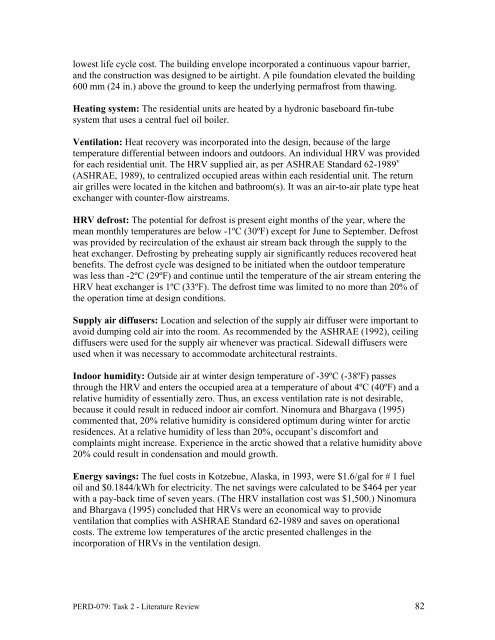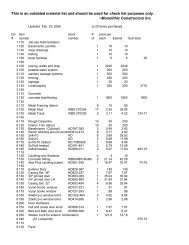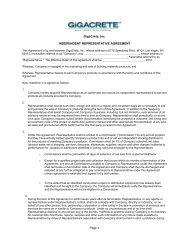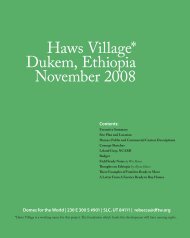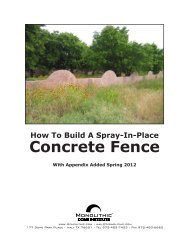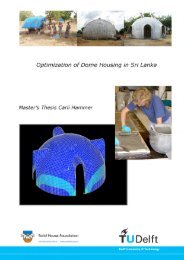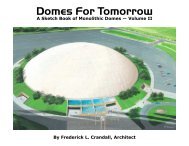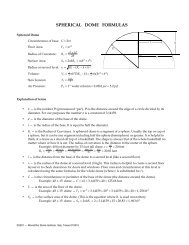Literature Review on Building Envelope, Heating and ... - Beeshive.org
Literature Review on Building Envelope, Heating and ... - Beeshive.org
Literature Review on Building Envelope, Heating and ... - Beeshive.org
Create successful ePaper yourself
Turn your PDF publications into a flip-book with our unique Google optimized e-Paper software.
lowest life cycle cost. The building envelope incorporated a c<strong>on</strong>tinuous vapour barrier,<br />
<strong>and</strong> the c<strong>on</strong>structi<strong>on</strong> was designed to be airtight. A pile foundati<strong>on</strong> elevated the building<br />
600 mm (24 in.) above the ground to keep the underlying permafrost from thawing.<br />
<strong>Heating</strong> system: The residential units are heated by a hydr<strong>on</strong>ic baseboard fin-tube<br />
system that uses a central fuel oil boiler.<br />
Ventilati<strong>on</strong>: Heat recovery was incorporated into the design, because of the large<br />
temperature differential between indoors <strong>and</strong> outdoors. An individual HRV was provided<br />
for each residential unit. The HRV supplied air, as per ASHRAE St<strong>and</strong>ard 62-1989 v<br />
(ASHRAE, 1989), to centralized occupied areas within each residential unit. The return<br />
air grilles were located in the kitchen <strong>and</strong> bathroom(s). It was an air-to-air plate type heat<br />
exchanger with counter-flow airstreams.<br />
HRV defrost: The potential for defrost is present eight m<strong>on</strong>ths of the year, where the<br />
mean m<strong>on</strong>thly temperatures are below -1ºC (30ºF) except for June to September. Defrost<br />
was provided by recirculati<strong>on</strong> of the exhaust air stream back through the supply to the<br />
heat exchanger. Defrosting by preheating supply air significantly reduces recovered heat<br />
benefits. The defrost cycle was designed to be initiated when the outdoor temperature<br />
was less than -2ºC (29ºF) <strong>and</strong> c<strong>on</strong>tinue until the temperature of the air stream entering the<br />
HRV heat exchanger is 1ºC (33ºF). The defrost time was limited to no more than 20% of<br />
the operati<strong>on</strong> time at design c<strong>on</strong>diti<strong>on</strong>s.<br />
Supply air diffusers: Locati<strong>on</strong> <strong>and</strong> selecti<strong>on</strong> of the supply air diffuser were important to<br />
avoid dumping cold air into the room. As recommended by the ASHRAE (1992), ceiling<br />
diffusers were used for the supply air whenever was practical. Sidewall diffusers were<br />
used when it was necessary to accommodate architectural restraints.<br />
Indoor humidity: Outside air at winter design temperature of -39ºC (-38ºF) passes<br />
through the HRV <strong>and</strong> enters the occupied area at a temperature of about 4ºC (40ºF) <strong>and</strong> a<br />
relative humidity of essentially zero. Thus, an excess ventilati<strong>on</strong> rate is not desirable,<br />
because it could result in reduced indoor air comfort. Ninomura <strong>and</strong> Bhargava (1995)<br />
commented that, 20% relative humidity is c<strong>on</strong>sidered optimum during winter for arctic<br />
residences. At a relative humidity of less than 20%, occupant’s discomfort <strong>and</strong><br />
complaints might increase. Experience in the arctic showed that a relative humidity above<br />
20% could result in c<strong>on</strong>densati<strong>on</strong> <strong>and</strong> mould growth.<br />
Energy savings: The fuel costs in Kotzebue, Alaska, in 1993, were $1.6/gal for # 1 fuel<br />
oil <strong>and</strong> $0.1844/kWh for electricity. The net savings were calculated to be $464 per year<br />
with a pay-back time of seven years. (The HRV installati<strong>on</strong> cost was $1,500.) Ninomura<br />
<strong>and</strong> Bhargava (1995) c<strong>on</strong>cluded that HRVs were an ec<strong>on</strong>omical way to provide<br />
ventilati<strong>on</strong> that complies with ASHRAE St<strong>and</strong>ard 62-1989 <strong>and</strong> saves <strong>on</strong> operati<strong>on</strong>al<br />
costs. The extreme low temperatures of the arctic presented challenges in the<br />
incorporati<strong>on</strong> of HRVs in the ventilati<strong>on</strong> design.<br />
PERD-079: Task 2 - <str<strong>on</strong>g>Literature</str<strong>on</strong>g> <str<strong>on</strong>g>Review</str<strong>on</strong>g> 82


